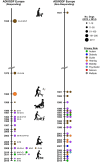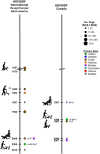Assistance Dogs: Historic Patterns and Roles of Dogs Placed by ADI or IGDF Accredited Facilities and by Non-Accredited U.S. Facilities
- PMID: 28154816
- PMCID: PMC5243836
- DOI: 10.3389/fvets.2017.00001
Assistance Dogs: Historic Patterns and Roles of Dogs Placed by ADI or IGDF Accredited Facilities and by Non-Accredited U.S. Facilities
Abstract
Dogs' roles to support people with disabilities are increasing. Existing U.S. laws and regulations pertaining to the use of dogs for people with disabilities are only minimally enforced. Pushback legislation against some aspects of uses of assistance dogs currently is being passed or proposed in several states. Further, the U.S. Department of the Army and the Veterans' Administration support only dogs trained by an Assistance Dogs International (ADI) or International Guide Dog Federation (IGDF) accredited facility. Lacking a mandatory national process for screening the selection, training, and placement of assistance dogs with persons who have disabilities, the U.S. offers a creative but confusing opportunity for people to train their own dogs for any disability. While no U.S. surveillance system monitors assistance dogs, other countries generally have a legislated or regulatory process for approving assistance dogs or a cultural convention for obtaining dogs from accredited facilities. We conducted an online survey investigating current demographics of assistance dogs placed in 2013 and 2014 with persons who have disabilities, by facilities worldwide that are associated with ADI or IGDF and by some non-accredited U.S. facilities. Placement data from ADI and IGDF facilities revealed that in most countries aside from the U.S., guide dogs were by far the main type of assistance dog placed. In the U.S., there were about equal numbers of mobility and guide dogs placed, including many placed by large older facilities, along with smaller numbers of other types of assistance dogs. In non-accredited U.S. facilities, psychiatric dogs accounted for most placements. Dogs for families with an autistic child were increasing in all regions around the world. Of dog breeds placed, accredited facilities usually mentioned Labrador Retrievers and Golden Retrievers, and sometimes, German Shepherd Dogs. The facilities bred their dogs in-house, or acquired them from certain breeders. Non-accredited facilities more often used dogs from shelters or assisted people in training their own dogs. Facilities in Europe and the U.S. place dogs in all roles; other parts of the world primarily focus on guide dogs. Expansion of assistance dogs in many roles is continuing, with numbers of dogs placed accelerating internationally.
Keywords: Assistance Dogs International; International Guide Dog Federation; autism dogs; diabetes dogs; hearing dogs; mobility dogs; seizure dogs; service dogs.
Figures





References
-
- Naderi SZ, Miklosi A, Koda A, Csanyi V. Co-operative interactions between blind persons and their dogs. Appl Anim Behav Sci (2001) 74:59–80.10.1016/S0168-1591(01)00152-6 - DOI
-
- Sanders CR. The impact of guide dogs on the identity of people with visual impairments. Anthrozoös (2000) 13(3):131–9.10.2752/089279300786999815 - DOI
-
- Whitmarsh L. The benefits of guide dog ownership. Vis Impair Res (2005) 1:27–42.10.1080/13882350590956439 - DOI
LinkOut - more resources
Full Text Sources
Other Literature Sources

